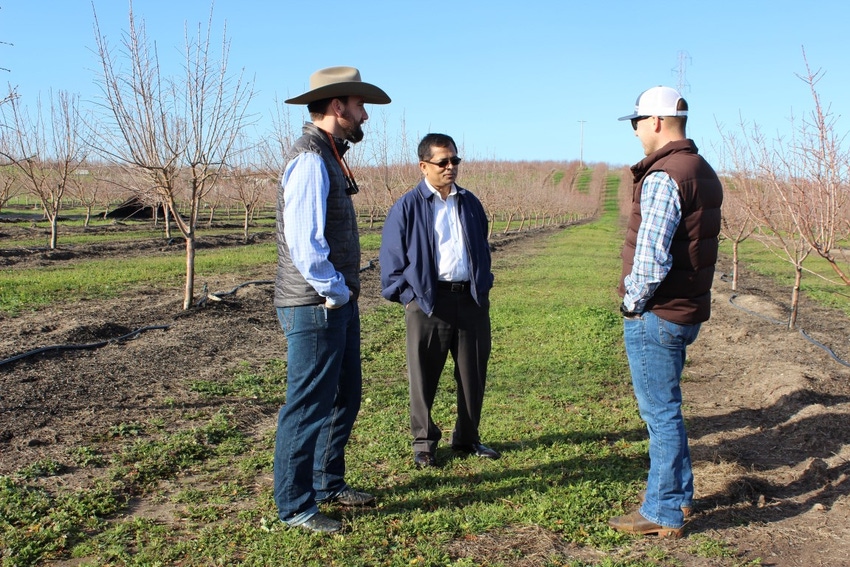
(Exclusive to Western Farm Press)
Although water supplies seem assured for the coming irrigation season, improving irrigation efficiency and accuracy is still an important goal for almond growers.
If systems are not distributing water uniformly, not only do trees suffer from over-watering or under-watering, nutrients supplied through the irrigation water are not distributed uniformly.
Understanding your system’s distribution uniformity is something that can be overlooked, and can have a large impact on water-use efficiency.
Growers should confirm that their irrigation system’s original design matches what is installed in the field soon after the system is in place. This test can help identify unknown issues and eliminate future headaches throughout the life of the system.
Distribution uniformity test
A grower can confirm this by having a simple distribution uniformity (DU) test done on their newly installed system. The test is a simple way to check to make sure that the irrigation system is performing properly. This test is considered critical for understanding how to maintain your irrigation system.
At a minimum, growers should check operating pressures throughout the system at least once a season. The irrigation system is no different from other pieces of equipment on the farm. It requires continued maintenance.
Years of research, much of it supported by Almond Board of California (ABC), has yielded extensive information on efficient irrigation water management, including how to conduct a DU test.
However, this information has not always been easy to find. So the ABC developed the Almond Irrigation Improvement Continuum, which brings together the information and numerous resources to assist almond growers in meeting current and future needs for irrigation efficiency and accuracy.
What is a Continuum?
While ‘continuum’ is not a word used every day, it represents something you do every day - a continuous series of steps taken to improve all aspects of the operation. It’s a way to continuously grow, evolve, and build upon past successes.
The Almond Irrigation Improvement Continuum focuses on accelerating almond grower adoption of research-based, commercially available, and increasingly water-efficient irrigation management scheduling tools. It has three levels of proficiency: Level 1.0, 2.0 and 3.0. It has been fleshed out through proficiency Level 1.0 and is online for growers to access in the form of a 54-page manual.
The manual provides comprehensive background materials and step-by-step ‘how-to’ guidance that pulls together numerous sources and reference information necessary to meet a basic level of irrigation efficiency. It is available both as a PDF and as an e-pub at www.Almonds.com/Irrigation.
Numerous technical experts have contributed to this comprehensive program of irrigation management and scheduling practices in these key areas:
Regularly assessing irrigation system performance and efficiency;
Estimating orchard water requirements based on evapotranspiration (ET);
Determining the applied water;
Evaluating soil moisture; and
Evaluating plant water status.
The online “Almond Irrigation Improvement Continuum 1.0” PDF and e-book go through the basics of these five categories.
In addition to the Continuum, a series of one-page handouts are available at www.Almonds.com/Irrigation. These address irrigation scheduling using ET, wen to begin irrigating almonds, almond salinity hazard and leaching requirements, what to consider before investing in irrigation technology, and calculating applied water.
Grower outreach
ABC’s objective is to assist all almond growers in meeting Level 1.0 proficiency, and working work with growers to progress along the Continuum through levels 2.0 and 3.0.
I am available to assist almond growers at any stage of Continuum adoption and can be reached at (209) 343-3231 and [email protected] for a consultation, to answer question, or arrange for an on-farm visit. I am also available for presentations at grower meetings, and happy to work with pest control advisers as well.
One-stop information source
As Larry Schwankl, UC Cooperative Extension Emeritus irrigation specialist, said at The Almond Conference last December that the information in the Continuum is not revolutionary, or wasn’t out there before but most of it was hard to find.
He said irrigation water management can be complicated, yet by taking the information and putting it in one place that almond growers should see how it fits together.
The big picture as addressed in the Continuum is to:
Know how much water to apply and when;
Know your irrigation system to determine how long (and how often) the system should be operated; and
Use the Continuum tools to check on how you are doing.
Moving up to 2.0
Once growers understand the Level 1.0 foundation, they find it very easy to advance through the Continuum, which includes more frequent estimates of water use to align water applications with the seasonally changing orchard water requirements. It also calls for improved irrigation system performance and the use of water measurement devices.
Additionally, soil and plant water status is more accurately measured, providing better information to verify irrigation scheduling.
About the Author(s)
You May Also Like




